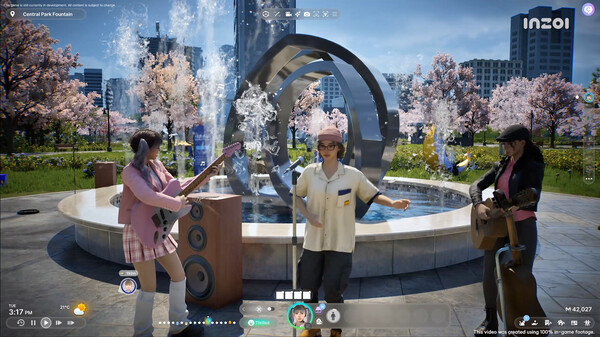With The Sims long ruling the life simulation games genre, there hasn’t been much in the way of innovation. And the creativity the game is so known for is increasingly locked behind paywalls: expansions, stuff packs, game packs, kits… The list goes on. Life simulation fans are desperate for a Sim’s alternative like InZOI.
With fans feeling microtransaction-ed to death by EA’s The Sims franchise, there might room for new genre royalty. Boasting more realistic graphics and a hyper-detailed character creation system, InZOI seems to take more inspiration by the best Sims mods than it does by the game franchise itself.
But there’s a catch. InZOI developer KRAFTON is open about using generative AI in their game to cut costs.
Generative AI, while undoubtedly a powerful tool with high potential, has come under fire for intellectual property infringement, being an environmental disaster, often dangerously (or hilariously) inaccurate, and being trained on the creative work of humans with the intent to replace them. So what are cozy gamers to-do when such an anticipated upcoming title like InZOI uses generative AI.

What is InZOI?
InZOI, by PUBG developer KRAFTON, has ambitions to be the next great life sim game. Set to release in late 2024, inZOI aims to rival The Sims by offering a highly detailed and customizable world where players have near-total control over their environment and characters.
The game is built using Unreal Engine 5 and boasts an impressive level of detail and customization. Players can shape every aspect of their world, from the appearance and behavior of characters (known as “Zois”) to the cityscape, weather, and even the social dynamics within the game. The game features an array of tools to edit and control various elements of the simulation, such as driveable cars, group activities, and a reputation system where your actions influence future gameplay.
One of the standout features of inZOI is its extensive character customization, which includes over 250 options to fine-tune aspects like age, body type, and outfits. The game also supports modding, encouraging players to create and share their own content.
InZOI’s Character Creator System
InZOI released a free demo of their character creation from August 21-24, 2024, so players could tinker with the system before release. I didn’t have a chance to test it out myself, but folks reported above-and-beyond levels of customizability as well as stunningly realistic graphics.
You can check out creators’ experiences with it on YouTube:
How Does InZOI Use Generative AI?
KRAFTON has admitted in a YouTube PR video to using Midjourney and Diffusion. Whether they pull from their own database of data, images, and assets or borrow from the stolen work of artists everywhere is currently unclear.
InZOI is the champion of future-forward tech, using Unreal’s Live Link Face app to mirror your facial expressions on your avatar in the game and is planning a full-body motion capture system. It’s probably no surprise, then, that generative AI makes an appearance in InZOI. Generative AI can be used to craft custom textures in the hyper-cutomizable character creator system and even turn photos into textures for items like clothing and accessories.
You can use it to create 3D models of everyday objects and add them to the game or type the word “daisy” into their generator and watch the system popular your floral request onto digital dresses or t-shirts for your Zoi to wear.
Gamers Weigh In on Generative AI in Games
A Reddit thread from November 2023 asked netizens for their opinions on generative AI use in inZOI. Here are some highlights:





Online folks seem split down the middle on this issue. There’s a sense that AI in games is inevitable and we should just shush up and accept it. But there is also a very real concern for the jobs generative AI is removing from the game development market, which is already seeing devastating layoffs everywhere.
Final Thoughts
We all know generative AI is here to stay and it’s cost-cutting potential for big name game developers is going to be hard to resist for too long. Content creation, curation, and circulation monopolies like Google, Meta, and Steam have a choke-hold on small creators who often need unconventional tech enhancements to “keep up” with the for-profit rat race bleeding all our beloved hobbies and passions dry.
Do we get mad at the small indie developer who uses AI to QA their game code—with a zero dollar testing budget for a team of one or two—when they would have otherwise had to spend days doing it manually? Do we boycott developers who use AI to bolster features, like “add absolutely anything”-levels of customization, that otherwise just…wouldn’t exist? Even I use ChatGPT to write my blog meta descriptions and summaries or do picky SEO work that, while vital to existing in an online space, just isn’t that much fun.
AI is too new to say for sure what the right course of action is. Stealing art is bad. Taking away jobs is bad. But Pandora’s Box is open…AI is out there, everywhere. We need regulation, safety precautions…but it’s naive to think it’s just going to go away. Can we coexist with a technology that seems to want to make the best parts of life, humans creating art, obsolete? Can we find a way to use it as a tool, to make human lives easier by automating the stuff we don’t want to do?
I’m not sure. But games like InZOI are breaking the mould to try and find out, push the limits—for good or for bad.
Stay cozy, gamers!
